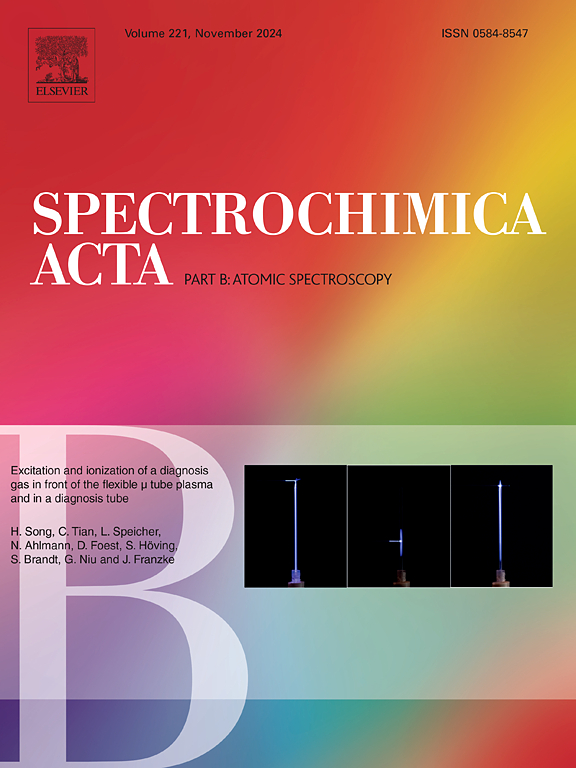Versatile system for ion energy measurements generated by pulsed laser ionization: Insights into electron-ion dynamics
IF 3.2
2区 化学
Q1 SPECTROSCOPY
引用次数: 0
Abstract
Ion energy distributions generated by pulsed laser interactions with materials are essential for applications ranging from materials science to oncology. Ion energy characterization is particularly important for an emerging mass spectrometry technique called virtual-slit cycloidal mass spectrometry (VS-CMS). The ion energy distribution influences the design and performance of VS-CMS instruments, as well as the efficacy of laser-driven ionization methods in various fields. Several established techniques, including the retarding potential method, time-of-flight (TOF) analysis, and electrostatic energy analyzers, have been employed to measure ion energy distributions. The wide range of ion energies reported highlights the strong dependence of ion energy on laser parameters, target materials, and experimental conditions, as well as the necessity of making independent measurements of the ion energy distribution for specific laser systems and materials. This paper presents the design and characterization of a simple TOF-based apparatus for measuring ion energy distributions from pulsed laser ionization without external fields. This approach minimizes perturbation of electron-ion dynamics and enables simultaneous energy measurements at multiple spatial positions. The apparatus was tested using a nanosecond pulsed Nd:YAG laser operating at 1064 nm, 532 nm, and 266 nm on solid copper sheets at various laser fluences. Simultaneous measurements at different distances provide new insights into ion-electron interactions post-ionization and demonstrate the influence of laser wavelength and fluence on ion energy distributions.

脉冲激光电离产生的离子能量测量的通用系统:洞察电子-离子动力学
脉冲激光与材料相互作用产生的离子能量分布对于从材料科学到肿瘤学的各种应用都是必不可少的。离子能量表征对于一种新兴的质谱技术——虚拟狭缝摆线质谱(VS-CMS)尤为重要。离子能量分布影响着VS-CMS仪器的设计和性能,也影响着激光驱动电离方法在各个领域的效果。几种已建立的技术,包括延迟电位法、飞行时间(TOF)分析和静电能量分析仪,已被用于测量离子能量分布。离子能量的广泛范围突出了离子能量对激光参数、靶材料和实验条件的强烈依赖,以及对特定激光系统和材料的离子能量分布进行独立测量的必要性。本文介绍了一种简单的基于tof的装置的设计和特性,用于测量无外场脉冲激光电离的离子能量分布。这种方法最大限度地减少了电子-离子动力学的扰动,并能够在多个空间位置同时进行能量测量。实验采用纳秒脉冲Nd:YAG激光器,工作波长分别为1064 nm、532 nm和266 nm。在不同距离的同时测量提供了电离后离子-电子相互作用的新见解,并证明了激光波长和对离子能量分布的影响。
本文章由计算机程序翻译,如有差异,请以英文原文为准。
求助全文
约1分钟内获得全文
求助全文
来源期刊
CiteScore
6.10
自引率
12.10%
发文量
173
审稿时长
81 days
期刊介绍:
Spectrochimica Acta Part B: Atomic Spectroscopy, is intended for the rapid publication of both original work and reviews in the following fields:
Atomic Emission (AES), Atomic Absorption (AAS) and Atomic Fluorescence (AFS) spectroscopy;
Mass Spectrometry (MS) for inorganic analysis covering Spark Source (SS-MS), Inductively Coupled Plasma (ICP-MS), Glow Discharge (GD-MS), and Secondary Ion Mass Spectrometry (SIMS).
Laser induced atomic spectroscopy for inorganic analysis, including non-linear optical laser spectroscopy, covering Laser Enhanced Ionization (LEI), Laser Induced Fluorescence (LIF), Resonance Ionization Spectroscopy (RIS) and Resonance Ionization Mass Spectrometry (RIMS); Laser Induced Breakdown Spectroscopy (LIBS); Cavity Ringdown Spectroscopy (CRDS), Laser Ablation Inductively Coupled Plasma Atomic Emission Spectroscopy (LA-ICP-AES) and Laser Ablation Inductively Coupled Plasma Mass Spectrometry (LA-ICP-MS).
X-ray spectrometry, X-ray Optics and Microanalysis, including X-ray fluorescence spectrometry (XRF) and related techniques, in particular Total-reflection X-ray Fluorescence Spectrometry (TXRF), and Synchrotron Radiation-excited Total reflection XRF (SR-TXRF).
Manuscripts dealing with (i) fundamentals, (ii) methodology development, (iii)instrumentation, and (iv) applications, can be submitted for publication.

 求助内容:
求助内容: 应助结果提醒方式:
应助结果提醒方式:


